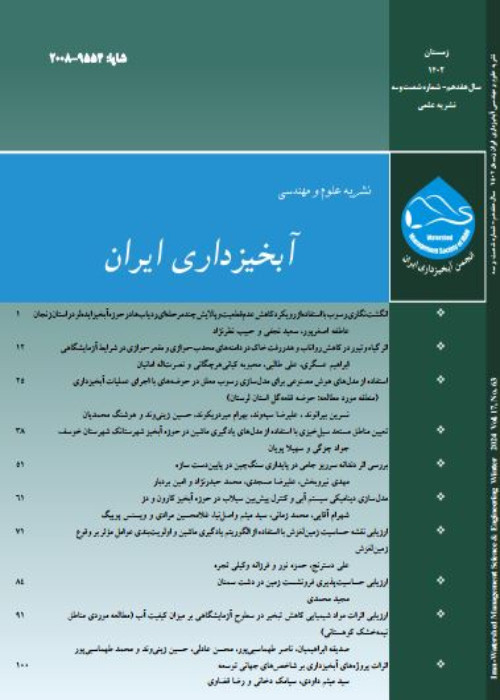Regeneration of plain by execution of artificial recharge project (case study; Sefieddasht- Faradonbeh plain)
Author(s):
Abstract:
Artificial recharge projects are in order to optimize use of water resources, aquifer especially, has significant role to play as a scientific and practical approach. Artificial recharge projects in Sefeiddasht- Fradnbeh plain was implemented for food security, in framework agricultural development and natural resources sustainable and optimal utilization of available resources and potentials. In this project, surface runoff a few springs and subterranean streams were used. These water resources are not usage in non-farm seasonal and enter into Borougens river and then join in the Karun River. The water enters into the pools of artificial recharge project with structures such as diversion dams, conveyance channels and the inverted siphon of road and then water was infiltrated into region aquifer. The current research project was implemented in order to evaluation yield and affected quantity in project related to stored water in aquifer. The results show that runoff input to the project was 6.1, 5.3 and 7.3 million cubic meters per year during 2003 to 2006 years respectively and they affected Sefieddasht plain and part of Faradonbeh plain. In order to affects of artificial recharge on water table and fluctuations in the volume of water stored in aquifer and groundwater resources management was used of Modflow model. For evaluation the performance and behaviour of the aquifer were used of six scenarios. Scenario no. 1: With normal time condition for implementation in the short term, medium term and long term (2, 15 and 30 years), Scenarios No. 2 and 3:In these scenarios average annual rainfall are assumed to reduce by 20 and 40 percent, Scenarios No. 4 and 5: In these scenarios average annual precipitationare enhance by 20 and 40 percent over entire area, and scenario no. 6: the scenario includes reduction in rainfall by 20 percent, reduction in canal seepage by 50 percent with increase in agricultural area by 20 percent, increase in domestic water demand by 10 percent. The results were that, scenario no. 1, for artificial recharge project area, the simulated results for 15 and 30 years of groundwater table fluctuation as it rises by 19.4 m and 23.9 m after 15 and 30 years of operation in the aquifer. in scenarios no. 2 and 3, the avarage groundwater table has gone down by almost 0.9 and 1.45 m as comapred to normal scenario or business as usual approach,in scenarios no. 4 and 5, the rise in water table were 1.45 and 2.69 meters, but scenario no. 6, groundwater table was reduce 3.45 meters in the whole area.
Keywords:
Language:
Persian
Published:
Iranian Journal of Watershed Management Science and Engineering, Volume:9 Issue: 31, 2016
Pages:
31 to 41
magiran.com/p1505933
دانلود و مطالعه متن این مقاله با یکی از روشهای زیر امکان پذیر است:
اشتراک شخصی
با عضویت و پرداخت آنلاین حق اشتراک یکساله به مبلغ 1,390,000ريال میتوانید 70 عنوان مطلب دانلود کنید!
اشتراک سازمانی
به کتابخانه دانشگاه یا محل کار خود پیشنهاد کنید تا اشتراک سازمانی این پایگاه را برای دسترسی نامحدود همه کاربران به متن مطالب تهیه نمایند!
توجه!
- حق عضویت دریافتی صرف حمایت از نشریات عضو و نگهداری، تکمیل و توسعه مگیران میشود.
- پرداخت حق اشتراک و دانلود مقالات اجازه بازنشر آن در سایر رسانههای چاپی و دیجیتال را به کاربر نمیدهد.
In order to view content subscription is required
Personal subscription
Subscribe magiran.com for 70 € euros via PayPal and download 70 articles during a year.
Organization subscription
Please contact us to subscribe your university or library for unlimited access!


